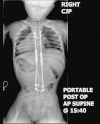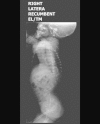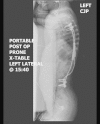Concurrent tethered cord release and growing-rod implantation-is it safe?
- PMID: 24353969
- PMCID: PMC3864420
- DOI: 10.1055/s-0032-1330941
Concurrent tethered cord release and growing-rod implantation-is it safe?
Abstract
Study Design Retrospective case series from one institution with a comparison control group. Objective To evaluate the safety of concomitant tethered cord release and growing-rod insertion in individuals with early onset scoliosis. Methods We retrospectively reviewed patients who underwent concurrent tethered cord release and growing-rod insertion. We compared our data to a comparison control group of eight patients who underwent staged tethered cord release and growing-rod insertion. Results We identified three patients meeting criteria. There were no neurological complications in the three patients who underwent concomitant surgery. Average immediate postoperative curve correction was 43.3 degrees (47.6%). We identified seven patients who underwent staged surgery from a multicenter prospective database. No neurological complications were reported, and average immediate postoperative correction was 35.1 degrees (46.2%). Conclusion We believe that concurrent tethered cord release and growing-rod insertion can be performed safely with the use of multimodality neurophysiological monitoring techniques.
Keywords: early onset scoliosis; neurogenic scoliosis; spinal cord monitoring; spinal growing rods; tethered cord.
Conflict of interest statement
Figures




Similar articles
-
Safety and efficacy of concurrent pediatric spinal cord untethering and deformity correction.J Spinal Disord Tech. 2011 Aug;24(6):401-5. doi: 10.1097/BSD.0b013e3182019f4d. J Spinal Disord Tech. 2011. PMID: 21150661
-
Is It Possible to Correct Congenital Spinal Deformity Associated With a Tethered Cord Without Prophylactic Intradural Detethering?Clin Orthop Relat Res. 2019 Jul;477(7):1689-1697. doi: 10.1097/CORR.0000000000000652. Clin Orthop Relat Res. 2019. PMID: 30801282 Free PMC article.
-
[The surgery treatment of scoliosis associated with tethered cord].Zhonghua Wai Ke Za Zhi. 2012 Apr;50(4):333-7. Zhonghua Wai Ke Za Zhi. 2012. PMID: 22800786 Chinese.
-
Autofusion in the immature spine treated with growing rods.Spine (Phila Pa 1976). 2010 Oct 15;35(22):E1199-203. doi: 10.1097/BRS.0b013e3181e21b50. Spine (Phila Pa 1976). 2010. PMID: 20683383 Review.
-
A high degree of variability exists in how "safety and efficacy" is defined and reported in growing rod surgery for early onset scoliosis: a systematic review.Spine Deform. 2020 Apr;8(2):269-283. doi: 10.1007/s43390-019-00004-4. Epub 2020 Jan 8. Spine Deform. 2020. PMID: 31925763
Cited by
-
The complex treatment paradigms for concomitant tethered cord and scoliosis: illustrative case.J Neurosurg Case Lessons. 2024 Jan 29;7(5):CASE23574. doi: 10.3171/CASE23574. Print 2024 Jan 29. J Neurosurg Case Lessons. 2024. PMID: 38285976 Free PMC article.
-
Intraspinal Anomalies in Early Onset Scoliosis: Current Concepts.J Pediatr Neurosci. 2018 Jul-Sep;13(3):294-301. doi: 10.4103/JPN.JPN_100_17. J Pediatr Neurosci. 2018. PMID: 30271460 Free PMC article. Review.
-
Management of concomitant scoliosis and tethered cord syndrome in non-spina bifida pediatric population.Childs Nerv Syst. 2017 Nov;33(11):1899-1903. doi: 10.1007/s00381-017-3504-0. Epub 2017 Jul 10. Childs Nerv Syst. 2017. PMID: 28695338
-
A comprehensive review of the diagnosis and management of congenital scoliosis.Childs Nerv Syst. 2018 Nov;34(11):2155-2171. doi: 10.1007/s00381-018-3915-6. Epub 2018 Aug 4. Childs Nerv Syst. 2018. PMID: 30078055 Review.
References
-
- Belmont P J Jr, Kuklo T R, Taylor K F, Freedman B A, Prahinski J R, Kruse R W. Intraspinal anomalies associated with isolated congenital hemivertebra: the role of routine magnetic resonance imaging. J Bone Joint Surg Am. 2004;86-A:1704–1710. - PubMed
-
- Bradford D S, Heithoff K B, Cohen M. Intraspinal abnormalities and congenital spine deformities: a radiographic and MRI study. J Pediatr Orthop. 1991;11:36–41. - PubMed
-
- McMaster M J. Occult intraspinal anomalies and congenital scoliosis. J Bone Joint Surg Am. 1984;66:588–601. - PubMed
-
- Prahinski J R, Polly D W Jr, McHale K A, Ellenbogen R G. Occult intraspinal anomalies in congenital scoliosis. J Pediatr Orthop. 2000;20:59–63. - PubMed
-
- Suh S W, Sarwark J F, Vora A, Huang B K. Evaluating congenital spine deformities for intraspinal anomalies with magnetic resonance imaging. J Pediatr Orthop. 2001;21:525–531. - PubMed
LinkOut - more resources
Full Text Sources

